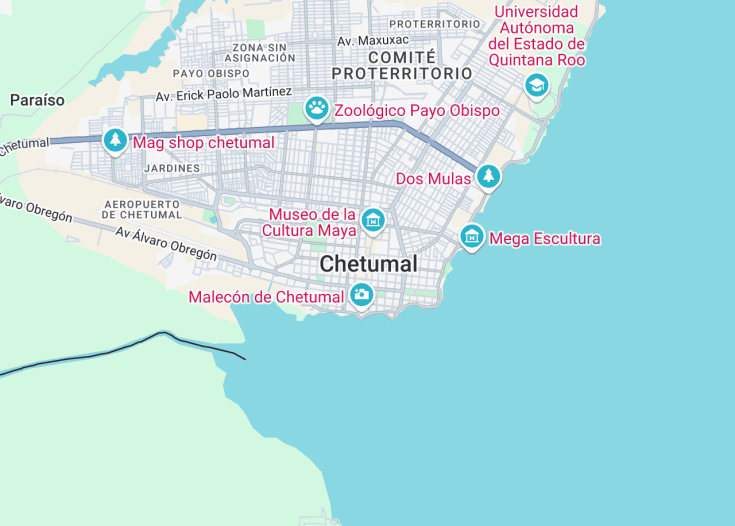Chetumal, the capital of Quintana Roo in Mexico, stands as a vibrant gateway to the Caribbean and a nexus of rich cultural heritage and natural beauty. This city not only offers access to stunning beaches but also serves as a starting point for excursions to nearby Mayan ruins and coral reefs.
It’s known for its museum that presents Mayan culture and its proximity to Belize, offering travelers a unique blend of experiences. Chetumal’s tranquil ambiance contrasts with the more tourist-centric areas of the Riviera Maya, making it a peaceful retreat for those looking to experience a more authentic slice of Mexican life.
For an immersive experience, visit the Museum of Maya Culture in Chetumal to understand the rich history and artistry of the Mayan civilization before exploring local archaeological sites.
Plan to visit Chetumal during the cooler, drier months from November to March for the most comfortable sightseeing experience and to participate in local festivals.
Top things to do & see in Chetumal
Select the following sights and activities to discover best tickets and tours available in Chetumal.
Chetumal: Gateway to the Maya Heartland
| Country | Mexico |
| Time in Chetumal | GMT-5 |
| Language spoken | Spanish |
| Population | 169,028 (INEGI 2020) |
| Currency | Mexican Peso (MXN $) |
| Airports | Chetumal International Airport (2 mi / 3.2 km). |
Chetumal, the capital of Quintana Roo in Mexico, melds a rich Maya heritage with vibrant Caribbean culture. Its location on the Bay of Chetumal offers scenic vistas and a gateway to exploring ancient Maya ruins and natural reserves. Established in the late 19th century, Chetumal has grown from a sleepy bay town to a bustling economic and administrative hub. It holds a pivotal place in Maya history, being a successor to the pre-Columbian city of Chactemal.
Today, Chetumal’s attractions include the Museum of Maya Culture, which showcases regional artifacts and interactive exhibits. The city serves as a starting point for journeys into deeper Maya territories such as Kohunlich and Dzibanche. The local cuisine, influenced by indigenous and mestizo traditions, offers distinctive flavors that celebrate its diverse cultural tapestry. Festivals, markets, and waterfront activities enrich the urban experience, making Chetumal an intriguing blend of past and present.
Where is Chetumal?
Situated near the borderline with Belize, Chetumal thrives in the southern part of Quintana Roo, Mexico, at the northern shores of the expansive Bay of Chetumal.
Distances:
| Route | Distance by car | Time by car |
|---|---|---|
| Cancún to Chetumal | 217 miles (349 km) | 4 hours |
| Playa del Carmen to Chetumal | 195 miles (314 km) | 3 hours 40 min |
| Tulum to Chetumal | 153 miles (246 km) | 3 hours |
What is Chetumal famous for?
Chetumal is renowned for its rich cultural history, serving as a cultural and trade foundation among the ancient Maya. It’s also known for its proximity to several important archaeological sites and its role as a commercial gateway between Mexico and Belize.
History
Pre-Columbian Era – Before 1500s
Chetumal, now the capital of Quintana Roo, Mexico, has a rich history dating back to its days as an important settlement for the Maya civilization. Known for its strategic location along the Mesoamerican trade routes, it thrived due to its access to both terrestrial and maritime pathways which facilitated trade of goods like cacao, jade, and obsidian.
Spanish Conquest to Colonial Era – 1500s to 1898
Following its discovery by Spanish explorers, Chetumal became part of the Spanish conquests in the Yucatan Peninsula. Throughout the colonial period, the area was somewhat neglected due to its geographical remoteness and the fierce resistance from the local Maya communities, leading to its slow development and sparse European settlement.
The Founding Era and Territorial Disputes – 1898 to Early 1900s
In 1898, Othón P. Blanco Núñez de Cáceres officially founded the city of Chetumal, initially named Payo Obispo. This era marked a significant period of development because of territorial disputes with neighboring Belize, then a British colony. The establishment of the city helped solidify Mexico’s claims over the region.
Modern Development – 1950s to Present
Chetumal underwent a transformation post-Mexican Revolution, further accelerated after World War II when infrastructural development began to take off. Its designation as the capital of Quintana Roo state in 1974 marked a major turning point in its urban and economic development, leading to modern advancements and growth as a cultural and administrative hub in the region.
Visit Chetumal
What to see and do in Chetumal
Chetumal offers a blend of cultural heritage and natural beauty. A key attraction is the Museum of Maya Culture, which delves into the rich history of the Maya people. Nature enthusiasts will relish visits to Bacalar Lagoon, known as the ‘Lake of Seven Colors’. Here’s where you can relax or engage in water sports.
- Explore the Museum of Maya Culture
- Relax by Bacalar Lagoon
- Visit the nearby Maya ruins, such as Dzibanché and Kohunlich
- Enjoy local cuisine at the city’s vibrant markets
Annual Events in Chetumal
Chetumal hosts several annual cultural and music festivals that celebrate its rich Maya heritage and contemporary culture. Notable among these is the Maya Cultural Festival, held in November, attracting artists and scholars from across the region to celebrate and educate on traditional practices and history.
Best time to visit Chetumal
The optimal time to visit Chetumal is from November through February. During these months, the weather is cooler and more pleasant, making it ideal for exploring the outdoor attractions and participating in local festivals.
Is Chetumal worth visiting?
Chetumal is certainly worth a visit, especially for those interested in Maya history and culture. With its unique museums, stunning natural attractions like the Bacalar Lagoon, and lively cultural festivals, Chetumal offers a less commercialized yet deeply enriching Mexican experience.
Whether you’re a history buff, nature lover, or cultural explorer, Chetumal provides a compelling blend of attractions that are both educational and enjoyable.










